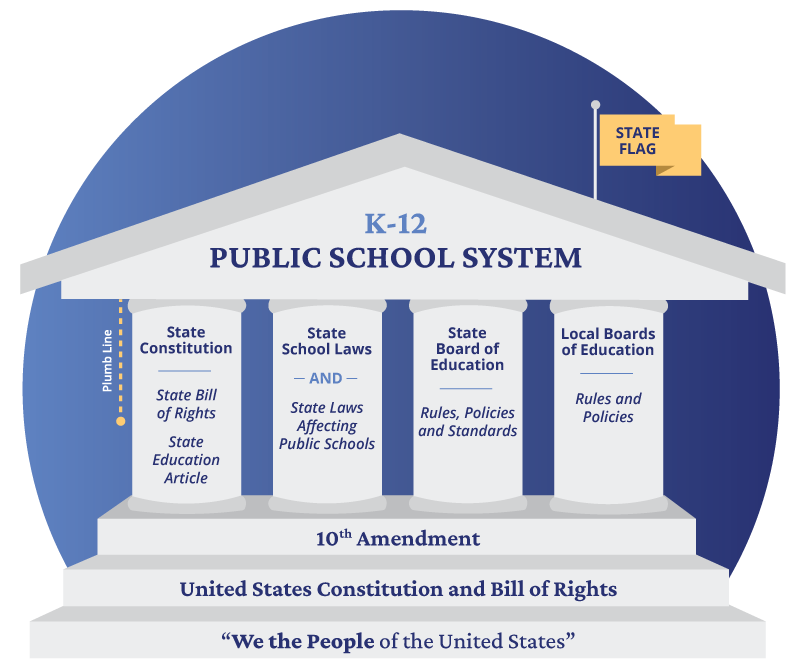Part 1
The State School System
That Governs Public Schools K-12
To many people’s surprise, all 50 state constitutions guarantee the right to a public education, which according to the U.S. Supreme Court, “is perhaps the most important function of state and local governments.”
To visualize each state’s public school system, see the diagram.

The state flag represents each state. Four columns support the building that, in order of importance, represent the following “levels” of the state’s public school system K-12:
- The state constitution, which is the most crucial document governing public education in the state, including the state bill of rights and the state education article;
- The state school laws and several other state laws, which are enacted by the state legislature, signed by the governor, and interpreted by the courts;
- The state board of education, which enacts rules, policies, and standards that govern public education in the state, and the state school superintendent, who is generally responsible for enforcing the state school laws and the state board of education rules; and
- The local boards of education, which enact rules and policies governing the public schools in their school district, and the local school superintendents, who are responsible for enforcing the local board of education rules.
To emphasize that the state constitution is the most crucial document governing public education, a vertical reference line (known as a plumb line) hangs beside the state constitution column. A “plumb line” is a reference line that involves a string, a weight, and gravity, to show the builder what is perfectly vertical. Then the building can be aligned or “trued up” parallel to the plumb line. Similarly, the three columns to the right of the state constitution (state laws; state board rules, policies, and standards; and local board rules and policies) must align with the state constitution and withstand constitutional scrutiny when challenged. You will see this diagram with the pertinent section highlighted throughout this book as we look at each level. You will also find many important laws and rules in your state. Then you can trace them from top to bottom, making sure that your school is following your state constitution, your state school laws, and your state and local board of education rules. This is how public education in each state is structured.
The U.S. Constitution does not expressly grant the federal government any power over education. There is also no federal constitutional right to a public education.2 However, Congress has been allowed to implement federal education programs under the U.S. Constitution’s “Taxing and Spending Clause.” U.S. Constitution, Article I, Section 8. In other words, only schools and school districts that accept federal monies are required to comply with federal education programs. Another aspect of federal involvement in education is the U.S. Constitution, which protects against government infringements (violations) of federal constitutional rights. For example, the U.S. Constitution’s Bill of Rights expressly protects the right to free exercise of religion, freedom of speech, and other rights that impact public schools. Additionally, the U.S. Supreme Court has repeatedly held (decided) that the U.S. Constitution gives parents a “fundamental right” to make decisions regarding the care, custody, control, upbringing, and education of their children.3 Given that parental rights are “fundamental rights,” the courts apply “strict scrutiny,” which is the highest level of scrutiny and the most challenging standard for a law or government action to meet. For more on the levels of scrutiny and constitutional rights, see Part II.
1 San Antonio v. Rodriguez, 411 U.S. 1 (1973); Brown v. Bd. of Educ., 347 U.S. 483, 493 (1954). See also, Wisconsin v. Yoder, 406 U.S. 205, 213 (1972) (stating that “[p]roviding public schools ranks at the very apex of the function of a state”).
2 San Antonio v. Rodriguez, 411 U.S. 1 (1973); Brown v. Bd. of Educ., 347 U.S. 483, 493 (1954).
3 Meyer v. Nebraska, 262 U.S. 390 (1923); Pierce v. Soc’y of Sisters, 268 U.S. 510 (1925); Wisconsin v. Yoder, 406 U.S. 205 (1972); Santosky v. Kramer, 455 U.S. 745 (1982); Troxel v. Granville, 530 U.S. 57 (2000).
